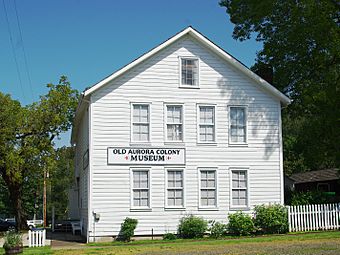Aurora Colony facts for kids
Quick facts for kids |
|
|
Aurora Colony Historic District
|
|

Museum dedicated to the history of the Aurora Colony, housed in the 1880 ox barn
|
|
| Location | Aurora, Oregon, US |
|---|---|
| Area | approx. 150 acres (61 ha) |
| Built | c. 1856 – c. 1881 |
| NRHP reference No. | 74001696 |
| Added to NRHP | April 16, 1974 |
The Aurora Colony, also known as Aurora Mills, was a unique Christian community. It was founded in 1856 by William Keil in what is now Aurora, Oregon, in the United States. This community was a type of utopian society, meaning people lived and worked together with shared goals and beliefs.
At its busiest in 1868, the Aurora Colony had about 600 members. They owned a large area of land, around 15,000 acres (6,100 ha). The colony, along with an earlier one Keil started called Bethel, officially ended in 1883. Years later, in 1974, about 150 acres (61 ha) of the former colony's land and 12 of its original buildings were recognized as important historical sites. They were added to the National Register of Historic Places as the Aurora Colony Historic District.
Contents
Who Was William Keil?
William Keil was a tailor born in Prussia, which is now part of Germany. He moved to the United States with his wife in the 1830s. He first opened a tailor shop in New York City. Later, he studied how to make medicines and opened a drugstore in Pennsylvania. People started calling him "Dr. Keil" around this time.
In 1839, Keil became a preacher after attending a religious meeting. He began to gather followers in Pennsylvania. Some of these followers had been part of another famous community called Economy Colony. In 1844, Keil and his followers created their first community, the Bethel colony, in Missouri. At its largest, the Bethel colony had 650 members.
Starting the Aurora Colony
Even though Keil's Bethel community in Missouri was doing well and could mostly support itself, he wanted to start another colony. He decided to expand to the Pacific Northwest of the United States. In 1853, he sent a small group to find the perfect spot for what he called "A Second Eden."
In May 1855, Keil and many members of his Bethel colony began a long journey by wagon to Washington Territory. Sadly, just four days before they left, Keil's son, Willy, died from malaria. Keil did not want to leave his son behind. So, he placed Willy's body in a special wooden coffin lined with lead. He then covered it with whiskey from the Bethel Distillery to preserve it during the journey.
The group first settled near Willapa Bay in Washington. After spending the winter there, Keil decided the land was not good enough for a farming community that could support itself. He then started looking for a new place. In 1856, he bought land and a working mill south of Oregon City. He named the new colony Aurora Mills, after his daughter, Aurora. The first group at Aurora Colony included 250 members who had traveled with Keil from the Bethel Colony.
Life in the Colony
The Aurora Colony was a busy place. The members built homes, schools, businesses, mills, and even a hotel. They also planted a fruit orchard and made many goods by hand. In 1870, the Oregon & California Railway line was extended to pass right through Aurora. This brought more business to the colony. The train would even stop four times a day for passengers to eat meals at the colony's hotel.
The Aurora Colony also had a very famous band. This band was well-known throughout the West Coast. They traveled to many places to perform their music.
William Keil was the only leader of the Aurora Colony. He was a very inspiring speaker. As the spiritual leader, he taught his own form of Christianity to the community. Keil preached simple ideas about brotherhood and love. He taught that there should be "No title but Christian" and "No rules but the Bible." He believed that all other religions were made by humans.
Like in many other special communities, the founder, Keil, had certain privileges. He asked members to confess their mistakes to keep them humble. However, he did not have to confess himself. He also did not have to do manual labor. Keil lived in a large house in the colony called "Gross Haus," which means "Big House" in German.
Smallpox Outbreak
In 1862, a member of the colony helped someone outside the colony who had smallpox. This person then brought the disease back to the Aurora Colony. As a result, many people in Aurora became sick, and many died. Four of Keil's children died during this outbreak, including his daughter Aurora, who the colony was named after.
The Colony Comes to an End
William Keil owned all the shared property of the colony in his name. In 1872, after his last remaining daughter died, Keil started to give ownership of the colony's land to individual families. He planned to transfer more land later. However, he died suddenly on December 30, 1877, before he could make any more transfers.
After his death, the members decided to close both the Aurora and Bethel colonies. The official end of the colonies was declared on January 22, 1883. The land later became the modern-day city of Aurora, Oregon.
Legacy of Aurora Colony
In 1966, the Old Aurora Colony Museum was created. This museum is dedicated to preserving and sharing the history of the colony. In 1974, twenty different sites in Aurora were added to the National Register of Historical Places, recognizing their importance.



